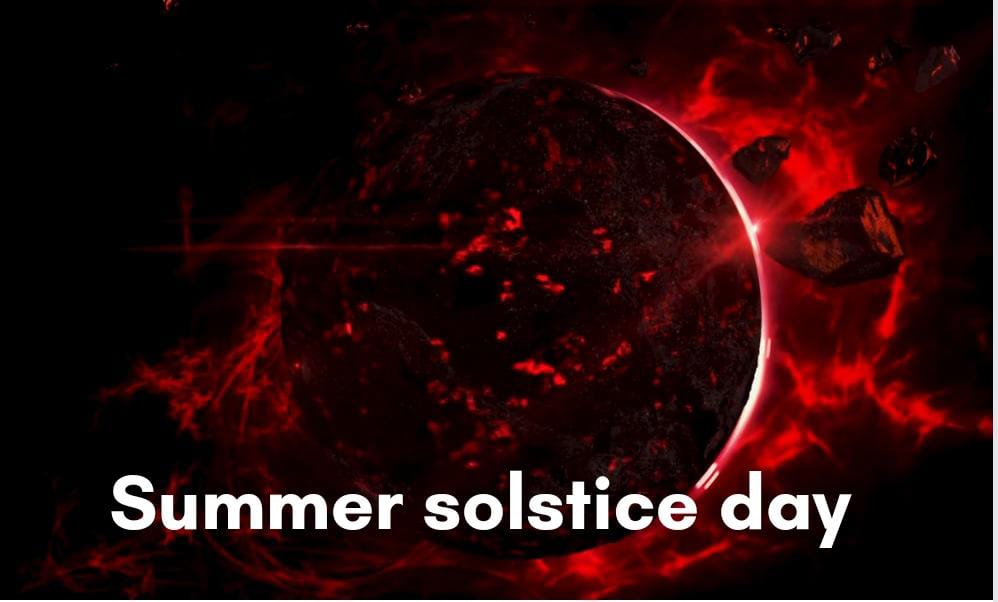Summer Solstice: Celebrating the Longest Day of the Year
The summer solstice day, also known as Midsummer, occurs when the Earth’s axial tilt is most inclined towards the sun, resulting in the longest day and shortest night of the year. This celestial event holds cultural, historical, and spiritual significance in many traditions worldwide, symbolizing abundance, vitality, and the power of the sun.
Table of Contents
The summer solstice day, also known as the June solstice or the June equinox, marks a significant event in the Earth’s annual journey around the sun. It occurs when the sun reaches its highest point in the sky, resulting in the longest day and the shortest night of the year in the Northern Hemisphere. The word “solstice” is derived from the Latin words “sol” (sun) and “sistere” (to stand still), reflecting the sun’s apparent pause in its journey before reversing its direction. Embracing nature splandor is the theme for Summer solstice day 2023.

History of Summer solstice day
The history of celebrating the Summer solstice dates back thousands of years, with various cultures and civilizations recognizing and honoring this astronomical event. Many ancient societies, such as the Egyptians, Greeks, Romans, and Celts, held solstice festivals as a way to mark the changing seasons and to celebrate the power and beauty of the sun.
In ancient times, the summer solstice held great cultural and spiritual significance. It was often associated with fertility, abundance, and the renewal of life. People would gather to participate in rituals, ceremonies, and festivities, which often included bonfires, feasts, dances, and music. These celebrations symbolized the triumph of light over darkness and the connection between humanity and the natural world.
One notable example of solstice celebrations is the festival of Midsummer, observed in many European countries. This tradition is rooted in pagan customs and was later incorporated into Christian festivities, such as Saint John’s Day. Midsummer festivals often involve lighting bonfires, dancing around maypoles, and enjoying outdoor gatherings and picnics. In modern times, the summer solstice is still celebrated and recognized in various ways. Many cultures and communities organize events and festivals to commemorate this special day. People gather at ancient sites, such as Stonehenge in England or Chichen Itza in Mexico, to witness the alignment of the sun with these historic structures.
Specific traditions and customs associated with the summer solstice may vary across cultures and regions, the essence of this day remains the celebration of light, warmth, and the harmonious rhythm of the seasons. It serves as a reminder to cherish the bountiful gifts of nature and to foster a deeper connection with the world around us.
Significance of the day :
The summer solstice holds several symbolic and cultural significances:
- Celebration of Light: The solstice is a celebration of the sun’s power and the triumph of light over darkness. It represents the peak of the sun’s energy and serves as a reminder of the vital role it plays in sustaining life on Earth.
- Connection to Nature: The summer solstice is a time to honor and appreciate the natural world. It is a reminder of humanity’s deep connection with the cycles of nature and the changing seasons.
- Renewal and Rejuvenation: Many people view the summer solstice as a time of personal and spiritual renewal. It is an opportunity to reflect, set intentions, and embrace new beginnings.
Why Celebrate the Summer Solstice day:
- Appreciation for Nature: Celebrating the summer solstice allows us to reconnect with nature and express gratitude for its abundance. It reminds us to cherish and protect the environment.
- Cultural Traditions: By participating in solstice celebrations, we honor the rich cultural heritage associated with this event. It provides an opportunity to learn from diverse traditions and engage in collective rituals.
- Personal Reflection: The solstice offers a chance for self-reflection, introspection, and setting intentions for personal growth. It can be a time to reassess goals, let go of negativity, and embrace positive changes.
How to Celebrate the Summer Solstice Day :
- Sunrise or Sunset Rituals: Witness the sunrise or sunset on the day of the solstice, preferably in a natural setting. Take a moment to reflect, meditate, or offer gratitude for the sun’s energy and the blessings in your life.
- Outdoor Gatherings: Organize or attend outdoor gatherings, picnics, or bonfires with friends and family. Enjoy nature, engage in lively conversations, and celebrate the beauty of summer.
- Nature Walks and Activities: Take a nature walk, hike, or engage in outdoor activities to connect with the natural world. Appreciate the vibrant colors, blooming flowers, and the abundance of life during this season.
- The summer solstice, also known as Solstice Day, is an astronomical event marking the longest day of the year in the Northern Hemisphere and the shortest day in the Southern Hemisphere. Throughout history, various cultures have celebrated this day, emphasizing themes of renewal, light, abundance, and the cycles of nature.
Overview
While Solstice Day doesn’t have a specific theme, it is often associated with the celebration of light and the triumph of light over darkness. It encourages people to connect with nature, appreciate its beauty, and recognize the interconnectedness of all living things. The solstice symbolizes the changing seasons and serves as a reminder of the balance between light and darkness.
On Solstice Day, people may focus on concepts such as renewal, personal reflection, and setting intentions. It is a time to express gratitude for the abundance of nature and to embrace positive changes. Many solstice celebrations involve gathering with others to foster a sense of community and connection.
It’s important to note that the interpretation and significance of the solstice may vary among cultures and individuals. However, the essence of Solstice Day lies in celebrating the natural rhythms of the Earth and finding inspiration in the cycles of life.
you can go through our others article by click over this link, stay tuned with us for more articles.

